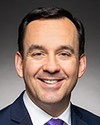Thank you very much. It's a real pleasure to be here today and an honour to appear before the committee.
I have a short presentation that will take me about 10 minutes, and then I think there's an opportunity to engage in a bit of a discussion and to dialogue after that.
In the first few slides, we really just talk a little bit about who Metrolinx is and what our role is in transportation planning for the greater Toronto and Hamilton area.
As you can see in slide 3, we're a relatively young organization. We were created only in 2006.
We were created to develop a more modern, more efficient, and more integrated transportation system for the greater Toronto and Hamilton area. We have three key words that drive our activities.
First of all, we're planning for the future. We're thinking in the short, the medium, and the long term, and we think typically in 25-year horizons. We deliver--and our objective is to deliver--quality transportation projects on time and on budget.
We also are responsible for the delivery of direct services to the public. You may be familiar with the GO Transit service, for example, the regional rail and bus service in the greater Toronto and Hamilton area.
We are a multimodal agency. We deal with all modes of transport. But today's focus really is to talk a little bit about the transit system, and I'm going to focus my remarks to that.
We have three operating divisions at Metrolinx. GO Transit is our rail and bus service that crosses the area. PRESTO deals with the smart-card-integrated system that allows people to pay for their transit fares on multiple transit systems. Our newest division is the Air Rail Link, which I'll talk about in just a few moments.
GO Transit is the largest part of our organization. It was launched in 1967 and came into Metrolinx as part of the organization in 2009. We carry about 59 million passengers on an annual basis. This means that about 150,000 passengers are carried into downtown Toronto each and every workday, and it has been growing very quickly over the past five years. We've had a ridership increase of about 21%, which works out to about 5% in each of the past five years. This year to date we're growing at about 8%.
We're proud of our 94% on-time performance, and we're also proud that one of our leadership responsibilities in the greater Toronto and Hamilton area is to raise the bar in customer service and improve the customer experience. We've issued what we've called a Passenger Charter. It gives a series of promises to our customers about the level of service they can expect from us.
We're using key performance indicators to report publicly, in a very transparent fashion, on how we're achieving against the promises we've made. We believe that's part of our role and responsibility: to drive change in the transit world in the region.
The PRESTO system is smart-card technology. It came into the Metrolinx organization in 2011. I'm pleased to say that we've rolled out this system across the entire GO rail and bus network, as well as in all of the local transit systems in what's called the 905 area, the regional or suburban transit systems in the greater Toronto and Hamilton area. We are currently at 12 TTC subway stations as well.
We are going to be deploying PRESTO here in Ottawa starting in the spring. We're in the final stages of negotiations with the TTC about deploying PRESTO on the balance of the TTC system over the next few years.
There currently are about 90,000 customers who have PRESTO in their wallets and purses. This is a significant information technology project that we've been able to deliver on time and on budget.
The Air Rail Link is a project that's under construction right now. Our objective is to have an operating air-rail link between Union Station, in downtown Toronto, and Pearson International Airport, by the spring of 2015. This will provide a reliable, fast, and comfortable level of service between the two largest passenger transportation hubs in Canada, with service every 15 minutes and travel time of approximately 25 minutes door to door.
The region that we're serving is a large, diverse, and growing area. There are currently about 6 million people in the greater Toronto and Hamilton area, which stretches from Hamilton in the west, through to the Oshawa-Clarington area in the east, and up to Barrie in the north. We have linkages to the areas immediately outside the greater Toronto and Hamilton area. We provide service to places like Niagara Falls, Barrie, Peterborough, Kitchener-Waterloo, and so on.
Because we're a transportation agency, we have to look at all modes of transport, particularly from central and eastern Canada. This is an important goods-movement corridor, with all rail corridors and road-based corridors heading toward the U.S. markets through the greater Toronto and Hamilton area.
We're growing by about 100,000 to 150,000 people each and every year. There are 10 transit agencies, and integrating and coordinating our activities is one of the big objectives that we have as an organization, in addition to making sure our connections are made to the surrounding area as well.
Just to give you a bit of a sense of the challenge we're facing, this slide shows an image from 2001, and the blue area does not necessarily represent good transportation service. These are areas where we're having congestion in peak periods. We estimated that in 2001 the impact on the regional gross domestic product was approximately $6 billion and resulted in 26,000 fewer jobs in the regional economy, and that's on an annual basis. That occurs each and every year.
We've also done forecasts to 2031, which is our planning horizon, of what it would look like if we did a business as usual approach. If we continue to invest in transportation at the rate we're investing, what would happen to our transportation system, based upon population and economic activity?
In that timeframe, we would have 2.6 million more people moving into this region. There would be about seven million more trips because of people travelling both to and from work, on leisure trips, and for other family reasons. Our current travel time in the region is estimated at 82 minutes a day, which, we're not proud to say, is among the highest in North America. In a business as usual environment, we estimate that our average annual commute times would grow to about 109 minutes each and every day, for both transit and road-based transport, and that $6 billion impact on our regional GDP would increase to about $15 billion, again in a business as usual context.
We clearly don't want to see that happen. We do have a plan, which we call “The Big Move”, which is about how we make sure that our future in the greater Toronto and Hamilton area is a more positive one, both for the region and in terms of the contributions we make to the national economy as well. We do have the largest transit expansion program in Canadian history under way right now.
Our 25-year integrated transportation plan is, again, a multimodal one, but we have four key transit-related goals. Our first goal is to double the mode share that transit has of daily trips. Our second goal is to triple the length of rapid transit in the region, which would include the subway system, the GO rail network, light rail transit, bus rapid transit, and those kinds of dedicated transit routes. Our third goal is to have 75% of the region's population living within two kilometres of transit, because accessibility to transit is a key determinant of people's use of transit, and it also makes sure that underserved communities have access to transit--to give them access to employment opportunities, for example. Our fourth key transit-related goal is to reduce commuting times.
I mentioned a few moments ago that business as usual would take us to an average commute time, on a daily basis, of about 109 minutes. If we implement the Big Move, as we've outlined it, we would drop that down to about 79 minutes, which you might say is not that great an improvement over the existing 82 minutes, but if you factor in the fact that we're also absorbing 100,000 to 150,000 people every year.... Keeping up with growth is a significant objective for us.
The final thing I would present as an objective is to reduce greenhouse gas emissions. Transportation is the single largest source of emissions to the environment. We estimate that we can reduce our urban transportation emissions by 40%.
The next slide really shows what we have today, which is a radial system that brings people very efficiently to downtown Toronto and has served that marketplace very well. What we want to move to in 2031 is something that imposes an east-west and north-south grid of transit services. That would essentially continue to serve the downtown area but, more importantly, would extend services to all the new employment areas that have been growing up all around the greater Toronto and Hamilton area, so that we would be serving not just the downtown Toronto area but the other employment nodes we have.
We have seven major projects under way right now to kickstart the implementation of our Big Move. This amounts to about a $16-billion investment and an unprecedented amount of work.
I'll just very quickly list the projects: the crosstown light rail transit, which is a project that spans 25 kilometres across midtown Toronto; York Viva bus rapid transit along Yonge Street and Highway 7 in York Region; the Air Rail Link, which I mentioned earlier on; a total refurbishment of Union Station; the 403 transitway in Mississauga; the subway extension of the Spadina line to Vaughan Corporate Centre; and the Brampton Züm system. This is a start towards the implementation of our transportation plan. It will be transformative in and of itself, but the key point is that we need to continue to invest in the transportation system for the future.
To give you a sense of where the funding is coming from for the $16-billion investment, we have about $14 billion of that coming from the provincial government and just over $1 billion from each of the federal and municipal governments.
I'd like to extend our appreciation to the federal government for the level of investment that has occurred over the last few years. It has been a great start to help us move on the implementation of the Big Move.
These funds do not include the numerous other small and medium-sized projects that are scattered across the region as well.
How do we move towards a more sustainable system? My premise is that there are unique challenges faced by the large city regions in Canada. The greater Toronto and Hamilton area, greater Montreal, and Metro Vancouver all face challenges from a transportation perspective that are different from those of other major cities.
Those challenges are caused by the geography and the size of the area we're dealing with, the scope of the population and the employment activity, and the complexity and the governance issues when we're dealing with multiple municipalities. In essence, we've outgrown the ability to solve our transportation challenges on a municipality-by-municipality basis. We need a regional solution to what is really a regional challenge.
We also have these city regions that in essence are our flagships globally. Supporting them is really important in terms of projecting the Canadian economy and what Canada is all about.
We also represent the area where about two-thirds of our transit ridership exists, and it also represents the biggest opportunity to increase transit ridership because of the strong connections among higher densities, mixed land use, and the transportation system.
The importance to the Canadian economy is really about congestion and relieving congestion in getting goods and services moving and also in the direct employment we can create through the implementation of the Big Move. We estimate that there will be about 430,000 new jobs, $21 billion in employment income, and GDP growth of a significant amount, as well as tax revenues going to all levels of government.
We realize, though, that at the same time there are significant fiscal realities that we must address. All levels of government are facing challenges right now. Municipalities lack the revenue capacity to make large investments in the transit and transportation systems. We are looking at alternative ways to raise revenue, because we are aware that governments at all levels have limited opportunity to make contributions through traditional revenue sources.
We do recognize that there's a role for the private sector, where appropriate, through alternative financing procurement. We believe that there's a need to use a suite of delivery models, from traditional methods of building, designing, and constructing transit through to alternative financing and procurement based on the nature of the project. We also believe that it's important for everybody to come to the table to deal with what is a large regional challenge that requires a regional solution.
We're very unique in that we have in our legislation for Metrolinx a clause that directs us to report to the province and the municipalities, by June 2013, with an investment strategy, which would include proposals for revenue-generating tools that may be used by the province and municipalities to support the implementation of the plan. Right now we are in the process of completing our global scan of how other jurisdictions have been using different revenue tools. Our next step is to engage with stakeholders and the public as to how we might apply some of these lessons and best practices from around the world in the greater Toronto and Hamilton area.
We believe the issue is urgent and the time is right to take action in terms of a national approach to transit infrastructure. We know through the research we do that transportation is the number one top-of-mind issue for residents in the greater Toronto and Hamilton area. The quality of the transportation system is a bigger concern to residents in the GTHA than the quality of health care or the quality of education. Reducing congestion on major highways is the number one priority, followed by improving mobility and expanding the public transit system, and there is widespread public support for solving our transportation challenges through a long-term plan that's dealt with on a regional basis.
Finally, the issue is urgent and the time is right for action. The need is significant. We are facing relentless growth. Again, 100,000 to 150,000 people are moving into the region on an annual basis. We are dealing with the fact that we have a generation of under-investment that we're also recovering from in terms of the state of good repair and catching up in terms of the expansion of the system.
The costs of inaction are quite severe, we believe, in terms of lost productivity to the economy, job loss, taxes, and investment. We believe the benefits of action are worth it to all levels of government. It helps to position our global cities in the world economy and it improves the quality of life for millions of Canadians.
That concludes my opening remarks. I'll be happy to take any questions from you.











